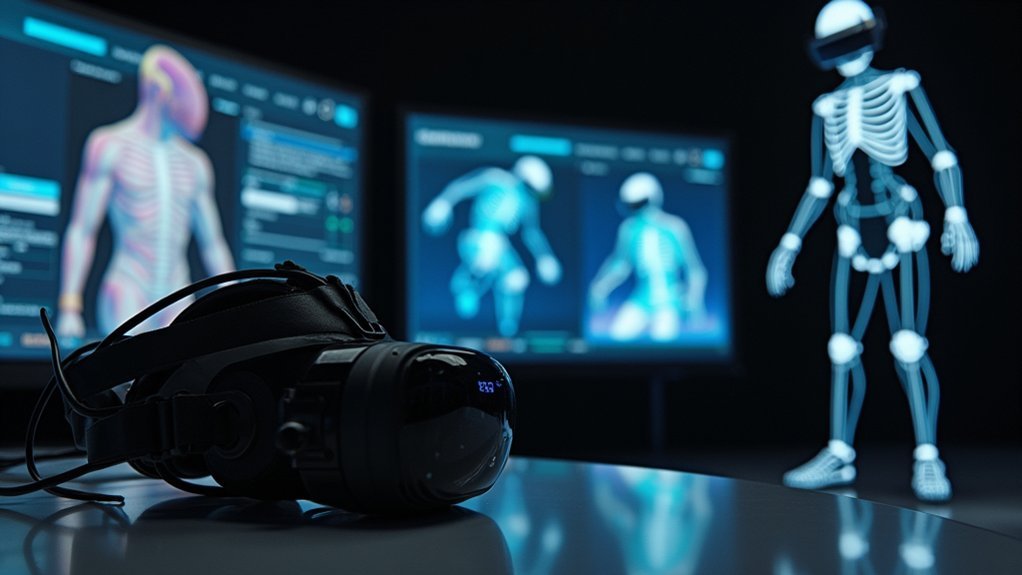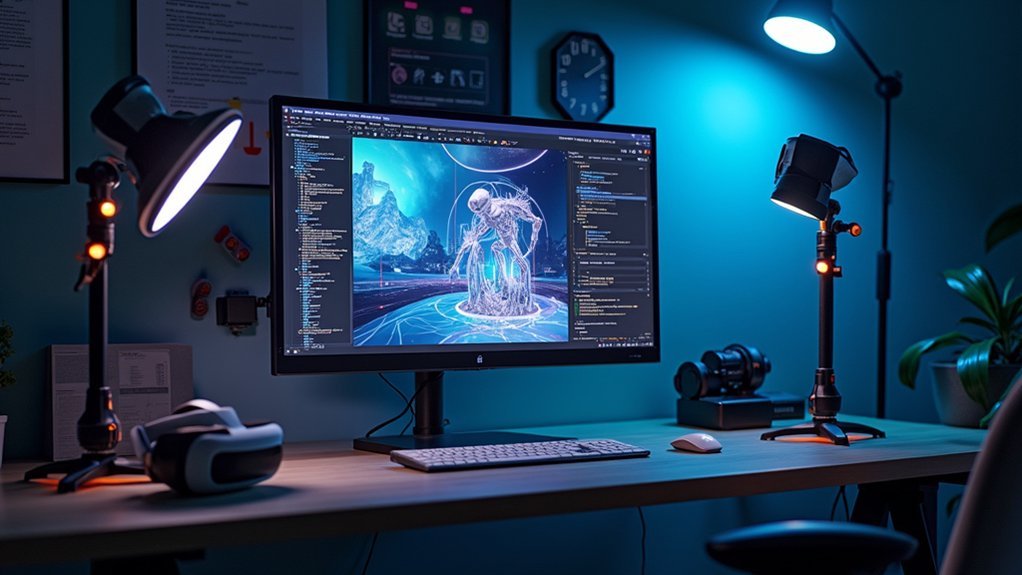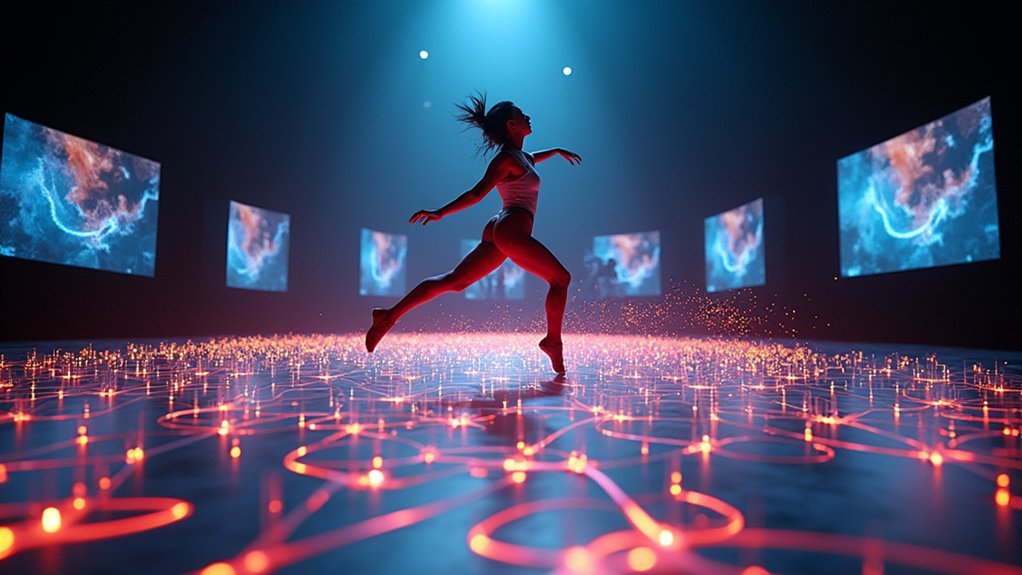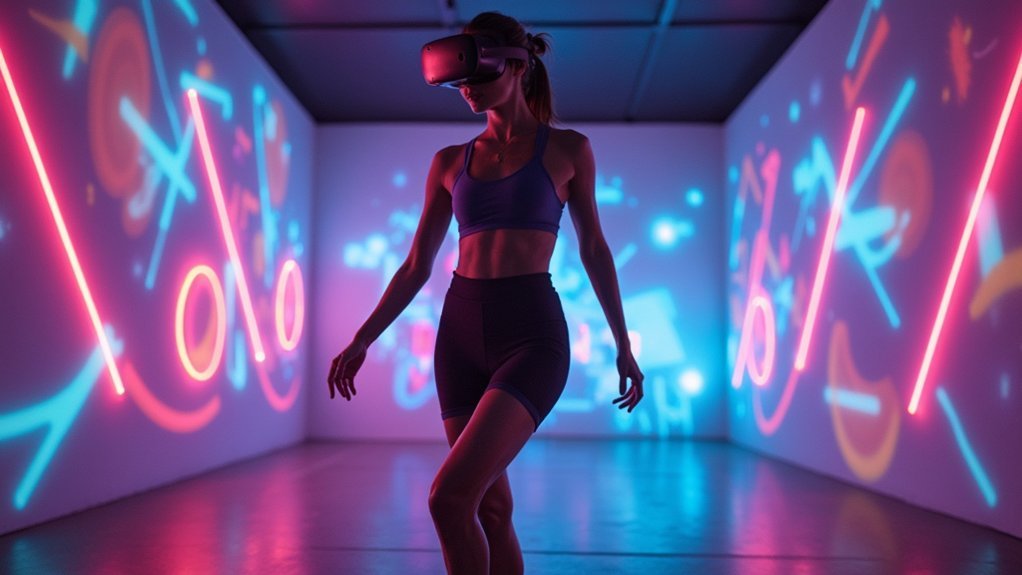You’ll transform your immersive development projects with motion capture SDKs that seamlessly translate raw tracking data into lifelike character animations through streamlined APIs and real-time processing. These powerful tools support full-body, facial, and hand tracking while integrating effortlessly with Unity and Unreal Engine, dramatically reducing development cycles and eliminating complex data conversion. They offer cost-effective, scalable solutions that accommodate various budgets and hardware setups, ensuring your VR experiences deliver authentic human movement that captivates users and future-proofs your creative investments as the industry evolves.
Understanding Motion Capture SDK Architecture for VR Applications

Motion capture SDKs serve as the architectural backbone that connects raw tracking data to your VR applications, transforming complex sensor information into usable character animations and interactions.
These development kits provide streamlined APIs that enable you to create realistic experiences without wrestling with complex data conversion processes. You’ll benefit from real-time data processing capabilities that let you monitor and adjust motion data during development, ensuring peak performance for your immersive development projects.
The SDK architecture supports standardized file formats like FBX and BVH, seamlessly integrating with your existing 3D animation workflow. This flexibility extends to hardware setup options, accommodating various tracking technologies.
With thorough documentation and sample projects included, you can quickly adapt motion capture technology into your VR applications, accelerating development timelines while maintaining professional quality results.
Real-Time Data Processing and Streaming Capabilities in VR SDKs
When you’re developing VR applications that demand instant responsiveness, real-time data processing capabilities become the vital bridge between physical movements and digital representation.
VR SDKs excel at translating motion capture data into seamless character animations through advanced streaming capabilities that eliminate delays between action and response.
You’ll find these SDKs support multiple input sources simultaneously, capturing full-body tracking, facial movements, and hand movements with remarkable precision.
The sophisticated algorithms optimize data fidelity while achieving essential latency reduction, ensuring your immersive experiences feel natural and responsive.
Live streaming integration lets you incorporate real-world performances directly into virtual environments, creating dynamic interactions.
You can iterate quickly during development, making real-time adjustments based on performance feedback and maintaining the fluid responsiveness that defines compelling VR applications.
Cross-Platform Compatibility and Engine Integration Features

As developers face increasing pressure to reach audiences across diverse platforms, cross-platform compatibility emerges as a defining characteristic that separates professional-grade motion capture SDKs from basic alternatives.
You’ll find that leading SDKs seamlessly deploy across PC, console, and mobile environments, maximizing your audience reach without compromising functionality.
Engine integration capabilities revolutionize your workflow through direct compatibility with Unity and Unreal Engine. You can stream motion capture data in real-time, enabling immediate feedback that accelerates iteration cycles and enhances animation quality.
Real-time motion capture streaming with Unity and Unreal Engine integration transforms animation workflows by enabling instant feedback and faster iteration cycles.
SDKs support standardized file formats like FBX and BVH, ensuring your captured data integrates smoothly across different animation software.
The development experience improves markedly through thorough documentation and robust community support, providing essential guidance for effective implementation and troubleshooting across platforms.
Advanced Tracking Technologies: Full-Body, Facial, and Hand Capture
While full-body tracking systems have dominated motion capture discussions, today’s advanced SDKs excel by combining thorough body movement detection with sophisticated facial and hand capture technologies.
You’ll find that full-body motion capture utilizes multiple cameras and markers to track your entire body, creating realistic character animations for gaming and virtual environments.
Facial motion capture captures your intricate expressions and lip movements, adding emotional depth to digital characters.
Hand capture systems track your finger and wrist movements, enabling detailed interactions and gestures.
These advanced tracking technologies work together, providing seamless integration of human movements into digital avatars.
You’ll experience considerably improved immersion and authenticity in interactive experiences through this extensive approach.
Developer-Friendly APIs and Documentation for Rapid Implementation

The sophistication of these tracking technologies means nothing without accessible implementation pathways for developers. Developer-friendly APIs in motion capture SDKs enable rapid implementation by facilitating seamless integration into your existing workflows.
Even the most advanced motion capture technology becomes meaningless without developer-friendly implementation tools that integrate seamlessly into existing workflows.
You’ll find well-documented resources with tutorials and sample code that accelerate learning, letting you leverage mocap technology without extensive experience.
These SDKs include robust error handling and debugging tools, helping you identify issues quickly during integration. When challenges arise, thorough support through community forums and direct technical assistance guarantees you can troubleshoot effectively.
Most importantly, compatibility with popular game engines like Unity and Unreal Engine streamlines your development pipeline, enabling rapid prototyping and iteration that keeps your immersive projects moving forward efficiently.
Performance Optimization and Latency Reduction in Immersive Environments
When immersive environments demand split-second responsiveness, motion capture SDKs deliver performance optimization through real-time data processing that eliminates the lag between your movements and virtual avatar responses.
Advanced algorithms like predictive modeling minimize delays during data transmission, guaranteeing your character movements stay synchronized with your actions.
You’ll benefit from edge computing integration that processes data closer to the source, dramatically improving latency reduction in your applications.
High-quality systems employ synchronized multi-camera setups for accurate data acquisition, maintaining seamless immersion throughout your experience.
Motion capture SDKs also incorporate robust error handling and failover strategies, assuring consistent performance during demanding scenarios.
This thorough approach guarantees your user experience remains smooth and responsive, even in dynamic immersive environments where every millisecond counts.
Cost-Effective Solutions for Independent and Small Studio Development
Beyond optimizing performance, motion capture SDKs now offer budget-friendly pathways for independent developers and small studios to compete with industry giants.
These cost-effective solutions democratize access to high-quality animation tools that were once exclusive to major studios with substantial budgets.
You’ll find that affordable mocap systems provide scalable options tailored to your specific needs and financial constraints.
Here’s how motion capture SDKs give indie developers a competitive edge:
- Real-time feedback accelerates development cycles, helping you meet tight deadlines efficiently
- Seamless integration with popular game engines like Unity and Unreal Engine simplifies your workflow
- Scalable pricing models accommodate various budget levels without sacrificing animation quality
- Professional-grade tools enable creation of lifelike animations that enhance immersive experiences and player engagement
Future-Proofing VR Projects With Scalable Motion Capture Frameworks
As VR technology evolves at breakneck speed, you’ll need motion capture frameworks that can adapt alongside your project’s changing requirements. Scalable frameworks guarantee your VR projects remain viable as hardware capabilities expand and industry standards shift.
These systems integrate seamlessly with Unity and Unreal Engine, providing real-time feedback that accelerates your development cycles while maintaining flexibility for future upgrades.
When you choose robust motion capture solutions, you’re investing in technology that grows with your ambitions. Whether you’re indie developers creating your first VR experience or expanding established studios, scalable frameworks accommodate varying team sizes and budgets.
Advancements in technology, including AI-driven modeling and sensor miniaturization, keep these systems future-proof. You’ll achieve lifelike character animations today while maintaining compatibility with tomorrow’s innovations, protecting your creative investments long-term.
Frequently Asked Questions
What Are the Benefits of Motion Capture?
You’ll capture lifelike movements that enhance realism and deepen player engagement. Motion capture streamlines your animation workflows, reduces production timelines, and lets you achieve complex character interactions that’ll make your games stand out competitively.
What Are the Disadvantages of Motion Capture?
You’ll face high equipment costs, need extensive physical space, deal with complex calibration processes, encounter hardware compatibility issues, and require significant training to master motion capture technology effectively.
What Is the Future of Motion Capture?
You’ll see motion capture evolve with AI-enhanced precision, making it more accessible for indie developers. You’ll experience hyper-realistic avatars, seamless AR/MR integration, and real-time feedback systems that’ll revolutionize gaming and entertainment.
Is Motion Capture Better Than Animation?
You’ll find motion capture excels at realistic movement and faster production, while traditional animation offers complete creative control. Your choice depends on whether you’re prioritizing lifelike realism or artistic stylization.





Leave a Reply